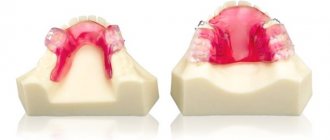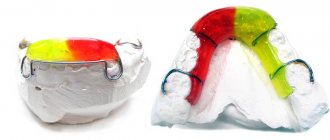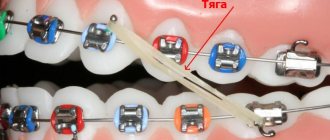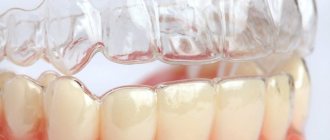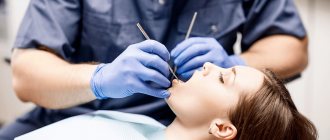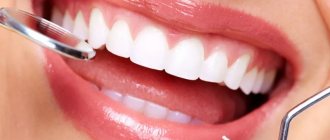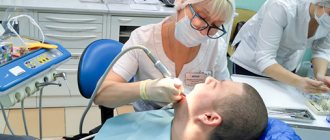There are many myths surrounding the concept of “bad bite”. Many believe that the position of teeth can only be corrected in childhood, the anomaly causes only aesthetic problems, and dental clinics only have braces at their disposal. Is it so? Let's figure it out.
Bite – the arrangement of the teeth when the jaws are closed. With a normal bite, each upper tooth is in contact with its lower “antagonist”, the dentition is even, there are no gaps.
You can correct the position of your teeth not only during the period of active growth. Of course, the easiest way to do this is in childhood. However, it is quite possible to eliminate the anomaly in adulthood. For this purpose, not only brace systems are used, but also various surgical methods, as well as microprosthetics.
It is important to understand that the success of orthodontic procedures depends on the condition of the teeth, the type of bite and the degree of pathology. The stronger the anomaly, the more difficult it will be to correct it.
What can be the consequences of an incorrect bite?
Lifespan
Scientists have now proven that people with correct bites live 20% longer.
One example is that with an incorrect bite, the lower jaw very often takes a posterior position, which reduces the lumen of the respiratory tract, in turn this leads to oxygen starvation of the heart and brain, and if this continues throughout life, you understand what changes can occur. And this is just one example. That is, this is not just aesthetics, as many people think - this is a real problem that can affect everyone, both children and adults.
Missing sixth teeth
Another example is the absence of sixth teeth, what could be the problem here? Our sixth teeth are the keys of occlusion, that is, they support the height of the lower jaw and the position of the lower jaw. When we lose or remove these teeth, some time passes and we do not make up for this loss, the position of the jaw changes, the height of the lower third of the face changes to a lesser extent - this is how an incorrect lower bite begins to form. Accordingly, the front teeth begin to wear out, because the load is redistributed from the back to the front.
What happens with this? Patients come to the dentist, ask for crowns, make some restorations, but do not take into account the position and malocclusion of the lower jaw, which has already changed pathologically.
Absolutely the same clinical picture is observed in the upper jaw; the absence of six teeth forms an abnormal bite.
Impaired diction and more
Along with dental disorders and defects that are associated with malocclusion, there is also a violation of diction. At the same time, the psychological state of the patients is not balanced: people cannot speak in public, they cannot smile brightly, well, beautifully. All these are the consequences of malocclusion, which, unfortunately, not everyone is ready to treat on time or even on time.
TMJ, bite and posture
Moreover, there are very serious consequences with the musculoskeletal system, because the temporomandibular joints (TMJ) suffer greatly from bite asymmetry. And then the disease may develop uncontrollably; changes may occur in the cervical vertebrae, then in the thoracic and lumbar spine, and this is the basis of our skeleton.
When a person begins, for example, to innervate a muscle, say, the arms or calves, he will pay 100% attention (!) not to the bite, which is incorrect. And it will be difficult to determine this at an older age, but you can and should start correcting malocclusion at any age.
When alignment with braces is not possible
You cannot straighten your teeth using braces if:
- Full or partial edentia. There will simply be nothing to consolidate the basics on.
- Acute mental disorders. A mentally ill person may want to remove the device themselves and cause harm to themselves.
- Diabetes mellitus, severe diseases of the immune and endocrine systems. With these pathologies, the condition of blood vessels and bone tissue worsens. If the tissue becomes inflamed after braces are installed, the tooth may become loose and fall out.
It is also not recommended to install braces if you have bleeding disorders, HIV infection, sexually transmitted diseases, tuberculosis, or oncology. Treatment of malocclusions using braces requires a responsible and competent approach. Therefore, it is very important to entrust the therapy to an experienced and highly qualified doctor.
How often is orthodontic treatment needed?
As an orthodontist with more than 20 years of experience, a large number of patients pass through me. But even with my experience in orthodontics, I meet people who refuse to believe and do not understand the whole situation with the malocclusion of their teeth.
In our team of dentists, we also specialize in orthodontics. After all, a person often comes to dentistry simply with a problem of caries or pain, and then the doctor, without actually imposing anything on him - without selling, tells him “everything as it is,” and the patient falls into a stupor, thinking “well, how can this be! I just came to put a filling...”
Let's talk about the ability of patients to recognize the problem of malocclusion. And also - why correct the bite and how to correct the bite.
In fact, many people are not prepared for what the doctor will tell them.
With such patients one has to follow a certain pattern of behavior. That is, we meet for the first time, I tell him that the person heard something, he has not yet realized it.
Then he comes the next time, we repeat this conversation, only with details, and until I see that the person himself wants to change something in his body, until he himself wants it, I do not take him into treatment. Why? Because everyone knows that 50% of the success of treatment depends on the patient himself; if he is motivated and wants to understand how to correct a malocclusion, everything will work out; the doctor alone cannot do it.
Often in our practice, especially with adult patients, we use an interdisciplinary approach together with surgeons, implantologists and orthopedists. Because, as a rule, when a patient seeks orthodontic treatment, it turns out that there are still a number of issues that need to be resolved with doctors of other specializations. At this moment, we do comprehensive consultations that last an hour and a half, and as a result of this consultation, our patient has an understanding of what will need to be done in order to achieve the desired result.
Prices
| Services | Price |
| Consultation | from 500 ₽ |
| The cost of a braces system to correct a bite | from 15,000 ₽ |
Today, the minimum cost of a brace system to correct a bite is fifteen thousand rubles. It is worth understanding that this price includes not only the cost of braces, but also the cost of diagnostics, maintenance (activation) of the brace system and a treatment plan, which depends on each specific case. And for treatment without braces, the cost depends largely on the device chosen. You can view the detailed price list on our website in the “Prices” section.
We recommend that you make an appointment with an orthodontist at any of our clinics, the addresses and telephone numbers of which are listed in the “Contacts” section.
Causes of malocclusion
How and why does malocclusion appear? And are there any ways to protect a child’s teeth at a very early stage of development of the dental system?
Let's start explaining what malocclusion is and what its types are.
Malocclusion is a fairly broad topic. It is best to start with bite prevention in children. So,
Prevention of bite in children
From the first days of a child, from infancy, breastfeeding is very important, because today it is recommended to feed a child for 6-9 months, the baby tries, sucks at the breast, his muscles work - his jaws develop. That is, with insufficient muscle activity, underdevelopment of the jaw bones occurs, which subsequently leads to more difficult to correct situations at later stages of the child’s development.
Because if a child’s jaw is underdeveloped - the teeth have grown and there is not enough space for them, then you need to think about what to do, so prevention and observation must begin from infancy. There are, of course, situations when the mother does not have milk, in which case it is better to choose bottles and nipples that are difficult to suck, so that the milk itself does not flow.
At what age should a child begin seeing an orthodontist?
It would be correct to show a child who is one year old to a doctor, if he does not have any anomalies - to an orthodontist. And the orthodontist will say that we wait until the child has all his teeth, and then we will take or not take any action.
Of course, if a child has caries, then we take every action to alleviate this situation, even going so far as to show mothers how to brush their teeth correctly, and children take an active part in this.
Our team of specialists includes doctors who see children. Now this age is from 6 years
.
What are braces
Braces are a non-removable orthodontic structure for the correction of developmental defects of the dentofacial apparatus. The bracket system consists of two main parts and fastening elements:
- • bracket plates attached using an adhesive composition to tooth enamel; • guiding power arc, which creates mechanical pressure on the teeth; • fasteners: ligatures (rubber rings or metal wire) or miniature locks. If ligatures are used, then the braces are called ligature. If the clasps are ligature-free (self-ligating).
The absence of one or more teeth leads to malocclusion
If we see adult patients, then, as a rule, the malocclusion pathologies that we most often encounter are associated with the absence of one or more teeth for quite a long time.
Is it necessary to correct the bite in such cases? Yes! If this situation is not corrected immediately, the teeth begin to move. Even if everything was fine with a person, but for some reason a tooth was removed, the teeth begin to move towards the defect of the missing tooth both in the lower jaw and in the upper jaw. The Popov-Godon effect develops.
What bite problems occur in this case?
Interdental contacts are disrupted, contacts between the upper and lower teeth are disrupted. Plus, a person begins to chew more on one side, that is, different muscle activity results, and the situation in the TMJ joint also changes.
And we work with all this and involve related specialists.
Orthodontics must be carried out, that is, we must return the teeth to their previous position, restore the missing tooth with an implant, as a rule, and then at the very end, if the teeth are worn out, the patient is transferred to an orthopedist.
By the way, if we talk about an orthopedic dentist, then the bite can be perfectly corrected with crowns - especially in the height of the bite. But high-quality primary treatment must be provided by an orthodontist.
Orthodontics at the Dent Ideal clinic
By choosing our clinic, you are choosing dentistry that keeps up with the times. Our specialists know the importance of a beautiful and healthy smile for every person - this is one of the main steps to success in any direction.
The clinic uses new technologies and has an experienced team of orthodontists who work with standard and complex cases. Our doctors do not rest on their laurels and regularly improve their skills and use innovative technologies recognized throughout the world. In our medical center, European service awaits you; with us you will get exactly the result you expected!
How to choose a good dentist for yourself, a child and a teenager?
In our work, we try to provide comprehensive treatment to our patients. Everyone knows that recommendations from friends and family are the main reason for choosing not only a dentist, but also other doctors. This is the so-called “word of mouth”, which was, is and will be.
Of course, now is the age of the Internet, everyone uses Internet resources, and you can find information by location, by service, and by some other criteria on the Internet. You definitely need to look at the reviews about dentists that are posted on these resources, you definitely need to come, meet and talk with this doctor, look at the place, the cleanliness, the surroundings of the dental clinic, its history and professional experience - these are all the necessary things that will subsequently lead to your choice. You need to summarize all these indicators, divide the piece of paper into two parts, write down the pros and cons. And where you get more advantages, that’s where you need to turn, to these specialists. Everything is very simple!
If there are no familiar doctors, and the patient needs to solve a problem, you still need to choose more according to the clinic, I think. There are clinics that still only accept dentists, orthopedists and hygienists. I believe that in such a narrow specialization as pediatric dentistry, there should be several pediatric doctors in the clinic if you want to bring a child there, if you are thinking about how to correct his bite.
If you come to an adult appointment, then each specialist should be doing his or her own thing, then it will be a more professional approach, that is, you need to look at the clinic as a whole and at the team of doctors as a whole. You must definitely come to the clinic and have a consultation, and perhaps go through more than one or two - this is a serious situation, so you need to carefully approach the choice and try, watch, visit, read and then make a choice.
Dental aesthetics in case of malocclusion
Is it worth getting your teeth done just for the sake of a smile and beauty?
It's impossible to separate here. Nature has honed man, the human body, his organism for hundreds of thousands of years. Function dictates form. In the process of human evolution, the correct form is perceived as beautiful. A healthy, strong body looks beautiful, you must agree. The same with teeth: if the teeth look beautiful, they are proportional, they are in the right position. This means that they function correctly, that is, function determines aesthetics. These are inseparable concepts and today dentists understand this.
In fact, as soon as a person acquires beautiful teeth, he immediately begins to smile more often, his life changes dramatically, because he is positive and he begins to attract the same people. For many people, their lives change after orthodontic treatment. Girls come and after orthodontic treatment are transformed - they get married and give birth. And they become smiling.
Modern methods of bite correction
You need to understand that orthodontic treatment takes quite a long time and, for example, for many people, braces are like a STOP sign. The question often arises: is it possible to correct a bite without braces?
What methods of bite correction are there for adults? Although this is also very important for teenagers.
If we talk about methods of treating incorrect position of teeth, then transparent aligners have recently appeared. But in America, for example, it is now fashionable to wear braces, and metal ones so that they can be seen - this tells others that a person is monitoring his health.
Today there are two main directions
in orthodontics.
1. These are classic braces
with arches that change throughout the treatment period.
Let's digress a little from braces and talk about them exactly the other way around - are there any patients who say we don’t want braces, let’s just get veneers and that’s it?
We are now talking about the situation of how to correct an overbite without braces. Yes, of course such patients do exist. You have to talk with them for a long time and still convince them that the orthopedist works with fixed teeth. What does an orthopedist do? He can glue veneers, he can treat the tooth for a crown (correct the bite with crowns), etc., but he cannot move the tooth - this is not his profile. Therefore, at the first stage of aesthetic dental treatment, an orthodontist can be involved. In some cases, veneers cope well with problems on their own; by the way, our team has accumulated many years of experience in installing veneers. Below, in the photo, one such situation is presented when the patient did without treatment with braces:
If we want to correct the incorrect position of teeth with the help of veneers or crowns, then we must grind off part of the tooth tissue. We try to convey to the patient that if there is a small orthodontic correction - we move the teeth into the correct position, then we will then install the veneers very delicately, that is, we will not grind off excess tissue. A person, of course, does not want to lose what he has, so he naturally agrees, the main thing is to explain, to convey it. The most important thing is not to do harm and to correctly explain to the patient what result we want to achieve, what will happen at the end of this treatment
2. These are transparent aligners - aligners
.
The principle here is this: a person’s jaw with teeth is scanned, loaded into a special program, the doctor-operator who works in this program carries out the virtual movement of the teeth step by step and a model and a mouthguard are made for each step. And what’s most important is that we can see the results of treatment even before it even begins. This treatment is calculated depending on the case from 10 to 30 or more mouth guards, but unfortunately there are also disadvantages to this method, he will say, some serious movements of the teeth, correction of such rather complex cases is impossible with mouth guards, although certain progress is now taking place in this method, this direction is developing, but so far it is not a panacea, that is, it does not apply to all cases.
About the specifics of treatment with braces
Do braces correct an overbite? Definitely yes! Most orthodontists work with straight arches, but not so long ago the multi-loop arch technique appeared, developed by the Japanese professor Sadao Sato: when he moved to Europe, he met the gnathologist Rudolf Slavichek. And in this union they came up with a concept. There are not many doctors in Russia who know such equipment.
What is the meaning of the multi-loop arc technique? A person who owns this technique, firstly, takes into account the position of the lower jaw, the position in the joint, and the multi-loop arch technique allows you to move each tooth individually in three planes, that is, when using it, treatment takes exactly six months less. And, as a rule, there are no relapses.
Often, orthodontists recommend wearing retainers for life after orthodontic treatment, wearing night guards for about a year, etc. If the tooth has taken its correct position, and the correct position of the tooth is the only one in the jaw, and the lower jaw in relation to the upper jaw also occupies the correct position, then there will be no relapse. With the help of the multi-loop arch technique, this is, in general, really possible to achieve, but here, of course, the orthodontist must have fairly in-depth knowledge.
Treatment with braces has its own main feature - they are developed by orthodontists themselves. Often, treatment with a braces system is based on the concept of one of its authors, with his logic of tooth movement in a particular malocclusion pathology. For example, the now popular Pitts 21 braces and its varieties. And in order to effectively treat a bite with such a brace system, you must have serious orthodontic experience and good medical practice.
In general, braces and braces are different - there are ceramic braces and lingual ones, but in any case, braces are one of the most reliable and working systems.
The multi-loop arch technique also involves treatment with classic braces, it’s just that the arch itself is different; the doctor makes it by hand individually for each tooth and creates its own curves.
There is another technique that has also gained popularity - the mini screw technique. A mini screw is installed in the jaw and a lock is glued to the tooth, traction is created and the tooth moves with the help of these mini screws, it is also very effective, you can work with teeth very quickly, but this is usually in adult patients, when teeth are missing and it is necessary to correct These defects occur in the long-term absence of 1-2 teeth.
How often does the question of braces or aligners come up?
What do you choose more - braces or aligners? About 5 years ago, aligners were not so affordable. But now there are a large number of manufacturers in different price categories. Among them, one can single out the undisputed leader - Invisalign, the quality of which has so far been unsuccessful, but numerous of its “analogs” are trying to approach.
How well do aligners correct a bite? Of course, the effectiveness of aligner malocclusion depends on the complexity of the case, and there are degrees of complexity within the aligner system itself (this is called case size). There is an opinion that with the help of aligners you can not correct, but correct the bite, so specialists already at the consultation determine which system to use for treatment. Therefore, I repeat once again, you need to come to doctors, you need to consult, you need to get a competent opinion, and each doctor in a particular situation chooses the system that will most effectively help the patient correct his bite. Thus, we again return to the qualifications and experience of the orthodontist, whom you trust to make your teeth straight and beautiful.
How do children feel about aligners, and how ready are they to have them installed?
I am currently treating a young patient, he is 14 years old. At the moment, preparations are underway for orthodontic treatment. He always says to both parents and doctors: “This is so cool, I’ll soon get aligners, great!” Nowadays they make such cool aligner systems that they are not just functional, they are very beautiful! Therefore, young patients have become more likely to agree to treatment with aligners. Young people have fewer and fewer complexes about correcting their bite. And this is great!
